When you get right down to it, the essential difference between red wine and white wine is beautifully simple: red wine gets its character from fermenting with grape skins, seeds, and stems, while white wine doesn't. This one single step is what gives red wine its signature colour, bold flavour, and grippy tannins, creating a world of difference from the lighter, zestier profile of a typical white.
Understanding the Core Differences in Wine
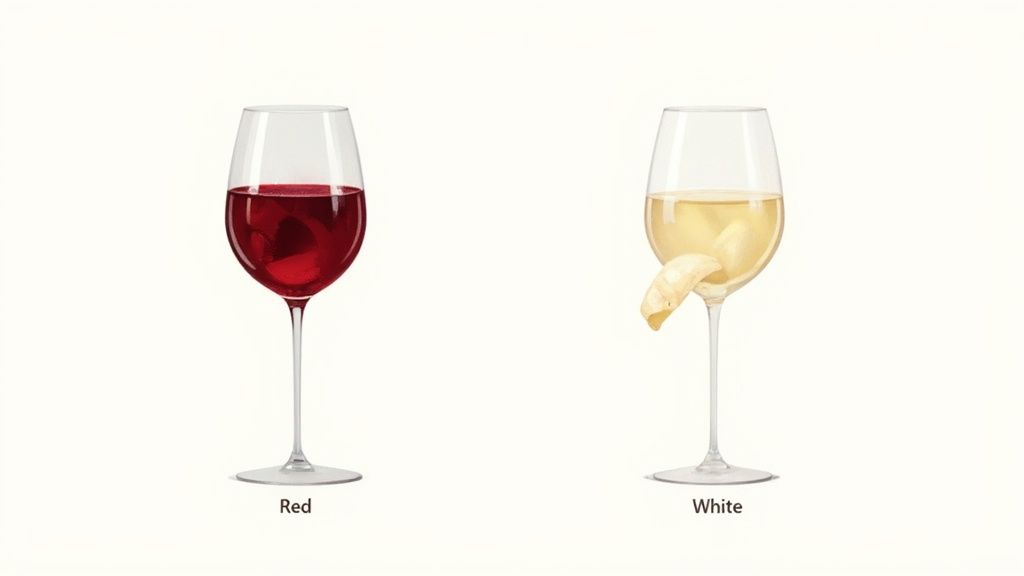
To really get a feel for wine, you have to understand what separates a big, bold Shiraz from a crisp Sauvignon Blanc. Both start their journey as humble grapes, of course, but their paths split dramatically once they hit the winery. The decision to either keep or ditch the grape skins during fermentation is the defining moment that shapes everything to come.
This fundamental choice kicks off a chain reaction, influencing everything from the wine's aroma to how it feels in your mouth. Red wines get their deep colours and complex structure from that skin contact, while white wines keep things light and delicate by pressing the juice away from the skins early on.
The Impact of Skin Contact
Grape skins are packed with the good stuff—compounds that are absolutely crucial to a wine's final personality. For red wines, letting the juice hang out with the skins during fermentation allows the winemaker to extract key elements:
- Colour: Those deep red and purple hues come from pigments called anthocyanins, which are found only in the skins.
- Tannins: These are the natural compounds that create that drying, slightly furry sensation on your tongue. They add structure and are a big reason why many reds can age so gracefully.
- Flavour Compounds: A huge chunk of a grape's aromatic identity is locked away in its skin, waiting to be released.
You can think of red winemaking as a slow steep, like making a rich tea. The juice soaks up all that colour, texture, and flavour. White winemaking, on the other hand, is all about capturing the pure, unadulterated expression of the grape juice itself.
This is the key to the whole red vs. white wine story. It’s why a Cabernet Sauvignon feels so textured and powerful, while a Pinot Grigio is zesty and light on its feet. To really understand how these elements come together, it helps to see them side-by-side. If you want to dive deeper into tannins, check out our article explaining why they matter in wine.
| Characteristic | Red Wine | White Wine |
|---|---|---|
| Fermentation | With grape skins, seeds, & stems | Juice only, skins removed |
| Primary Flavours | Dark fruits (berries, plums) | Citrus, green & tropical fruits |
| Body & Texture | Medium to full-bodied, often tannic | Light to full-bodied, smooth |
| Typical Acidity | Lower to moderate | Higher, often crisp & zesty |
The Winemaking Journey From Grape to Glass
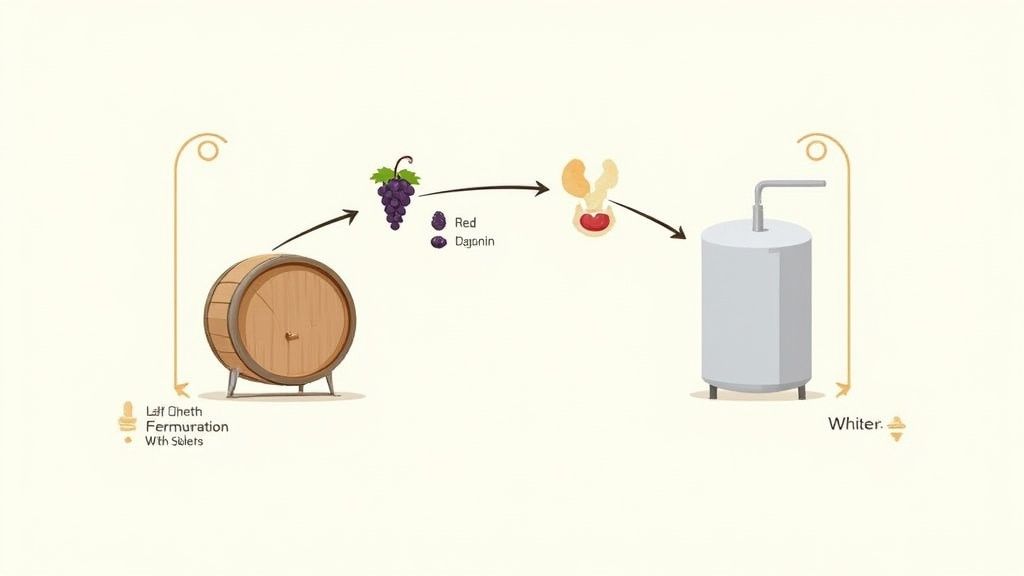
While the final wine in the bottle might seem worlds apart, every red and white wine begins life in the same place: the vineyard. The journey from a sun-ripened grape to a finished wine is a fascinating process, but the real fork in the road—the defining moment—happens right after the harvest.
It’s here that one fundamental decision about skin contact sets the two styles on completely different paths. This single choice dictates nearly everything that follows, from a wine’s deep ruby colour to its light, ethereal body. Understanding this split is key to appreciating why a Cabernet Sauvignon and a Sauvignon Blanc offer such wildly different experiences.
The Critical Divergence: Fermentation
The biggest difference in how red and white wines are made all comes down to fermentation. For red wines, the process is an immersive bath where the juice, skins, seeds, and sometimes even stems are all fermented together in a single vat.
This extended hang-time, known as maceration, can last for days or even weeks. During this period, the fermenting juice acts as a solvent, pulling out all the crucial elements that make a red wine red. Pigments from the skins bleed into the juice, creating the spectrum of red hues, while tannins from the skins and seeds provide structure, texture, and the backbone needed for ageing.
White winemaking, on the other hand, is all about separation. Grapes are typically crushed and then immediately pressed, whisking the juice away from the skins and seeds before fermentation even begins. This protects the juice’s purity, preventing the extraction of colour and heavy tannins. The result is a wine that’s lighter in both body and colour, with a laser focus on fresh fruit flavours and zippy acidity.
The core principle is simple: red winemaking is about extraction, pulling character from the grape solids. White winemaking is about preservation, protecting the delicate character of the juice itself.
A Side-by-Side Production Comparison
To really see how these two methods shape the final product, it helps to break down the key stages side-by-side. This table shows just how different techniques are used to achieve completely different goals.
Key Production Differences: Red vs White Wine
| Production Stage | Red Wine Process | White Wine Process | Impact on Final Wine |
|---|---|---|---|
| Crushing | Grapes are crushed to release juice, which stays with the skins and seeds. | Grapes are crushed and quickly sent to the press for separation. | Reds begin extraction immediately; whites aim for clean, pure juice from the start. |
| Fermentation | Juice ferments with skins and seeds at warmer temperatures (20-32°C). | Juice ferments alone at cooler temperatures (12-22°C). | Warmth helps extract colour and tannin for reds; coolness preserves delicate floral and fruit aromas in whites. |
| Pressing | Occurs after fermentation to separate the new wine from the solids. | Occurs before fermentation to separate juice from the solids. | This is the fundamental structural difference that defines the two styles. |
| Ageing | Often aged in oak barrels to add complexity, soften tannins, and introduce new flavours. | Typically aged in inert stainless steel tanks to maintain freshness. Some styles (e.g., Chardonnay) see oak. | Oak adds spice and vanilla notes to reds; steel keeps whites crisp and fruit-forward. |
The intricate steps involved in red wine showcase the winemaker's craft in balancing all these extracted elements. To see a detailed walkthrough, you can learn more about how red wine is made in our step-by-step guide.
Maturation and Finishing Touches
After fermentation, the paths continue to diverge, with the choice of ageing vessel playing a final, crucial role.
Most red wines benefit from spending time in oak barrels. The porous nature of the wood allows for slow, controlled oxygen exposure, which helps to soften harsh tannins and integrate flavours, creating a smoother, more complex wine. The barrel itself also imparts its own character—think vanilla, spice, and toasted notes.
In contrast, the vast majority of white wines are aged in stainless steel tanks. These inert containers prevent any interaction with oxygen, preserving the wine’s bright acidity and primary fruit aromas. The goal is simply to bottle the wine with all its vibrant, fresh character intact. Fuller-bodied whites like Chardonnay are a notable exception, often fermented and aged in oak to build a creamier texture and richer flavour profile. This final stage solidifies the distinct identity of each wine, born from that initial decision back at the press.
Decoding the Spectrum of Wine Flavours
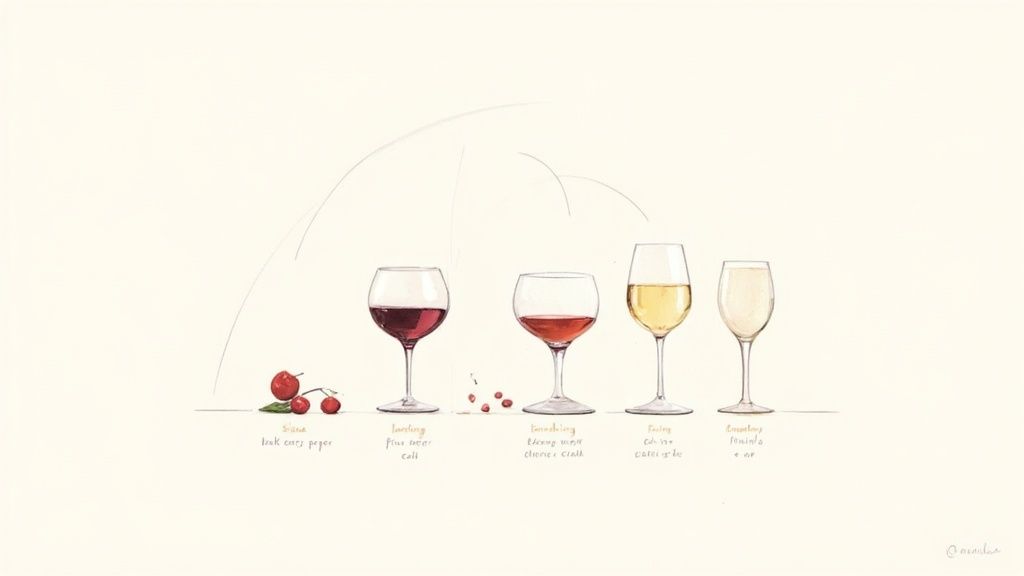
Diving into wine is like exploring a vast sensory map. Every bottle offers a unique landscape of aromas, flavours, and textures, and the classic red wine vs white wine debate almost always comes down to these profiles. They're shaped by everything from the grape variety and the climate it grew in to the final touch of the winemaker.
Getting a handle on these flavour profiles is your ticket to discovering what you genuinely love. It's how you move beyond just picking "red" or "white" and start choosing wines that perfectly suit your palate, the meal you've planned, or the occasion you're celebrating.
The Bold and Complex World of Red Wines
Red wines are all about structure and depth. That’s thanks to the tannins and flavour compounds pulled from the grape skins during fermentation, creating a spectrum of tastes from light and fruity to powerful and savoury.
Think of a classic Barossa Valley Shiraz. It's famous for its bold, full-bodied character, hitting you with powerful notes of dark blackberry, plum, and a signature kick of black pepper or spice. The tannins are firm, giving the wine a rich, textured mouthfeel that’s built to stand up to hearty food.
Now, contrast that with a Pinot Noir from a cooler spot like the Yarra Valley. This wine is far more delicate and nuanced. Its profile leans into bright red fruits—think cherry and raspberry—often with subtle earthy or savoury undertones of mushroom and forest floor. The tannins are much softer and silkier, creating a lighter, more elegant experience on the palate.
The key takeaway for reds is texture. Tannins, which come from the skins, create that drying sensation in your mouth. This structural backbone is what makes red wine such a brilliant partner for rich, fatty foods like steak; the tannins cut right through the fat and cleanse your palate.
While popular tastes always shift, reds and whites both have their die-hard fans in Australia. A 2019 survey found that among regular wine drinkers, 45% had enjoyed a Chardonnay in the past six months, compared to 23% for Shiraz. It's an interesting snapshot, though it reflects a specific variety's popularity rather than the total volume of red versus white consumed. You can dig into more insights on Australian wine preferences at Statista.com.
The Crisp and Aromatic Realm of White Wines
White wines tell a different story. Fermented without the grape skins, their personality is driven by acidity and bright fruit aromas. The result? Wines often described as crisp, zesty, and seriously refreshing.
Take a classic Clare Valley Riesling. It's known for its piercing acidity and vibrant citrus notes of lime and grapefruit, often with a distinct minerality that brings wet slate to mind. These wines are typically bone-dry, light-bodied, and incredible on a warm day or paired with fresh seafood.
On the other end of the white wine spectrum is something like a Margaret River Chardonnay, especially one that has seen some oak. It still has that backbone of acidity, but the flavour profile is much richer and creamier. Here, you'll find notes of yellow apple, melon, and stone fruit, layered with delicious flavours from the oak barrel like vanilla, butter, and toasted almond.
Comparing Key Sensory Components
To really nail the difference between red and white wine, it helps to put their core sensory elements side-by-side.
- Tannin: This is almost exclusively a red wine thing. It adds bitterness, astringency, and complexity, creating a structural framework that helps the wine age. White wines? Generally no perceptible tannins.
- Acidity: Acidity is crucial for both, but it's often the star of the show in white wines, giving them freshness and that mouth-watering crispness. In reds, acidity is the quiet hero that balances the fruit and tannins, stopping the wine from tasting flat.
- Body: This is all about the weight and texture of the wine on your palate. Reds, with their tannins and often higher alcohol, tend to be medium to full-bodied. Whites are typically lighter, though an oaked style like Chardonnay can bring a similar richness.
- Aromas: Red wines often deliver red and black fruit aromas (cherry, blackberry), along with secondary notes like leather, tobacco, and spice. White wines showcase citrus, green, and tropical fruits (lemon, green apple, pineapple), often with floral or mineral notes.
Once you start to identify these key components, you can better describe what you like. Knowing you enjoy the high acidity of a Riesling or the firm tannins of a Cabernet Sauvignon empowers you to explore new wines with confidence, making sure you always find a bottle you'll love.
Mastering the Art of Food and Wine Pairing
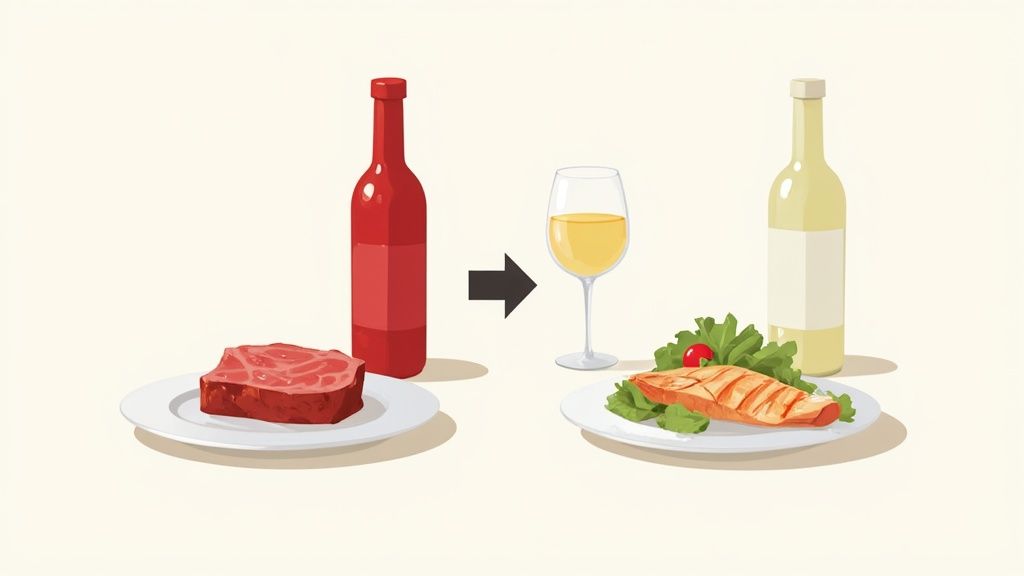
Pairing wine with food is far less about rigid rules and much more about creating a bit of magic on your palate. Let's start by forgetting the old "red with meat, white with fish" mantra. A modern approach is all about balancing the key players in both the dish and the wine, with the ultimate goal of making both taste even better together.
The core idea is beautifully simple: match the weight and intensity of the wine to the weight and intensity of the food. A delicate dish like grilled snapper will be completely steamrolled by a big, bold Shiraz. On the flip side, a light Pinot Grigio would get lost next to a hearty lamb stew. This is really the foundation of the whole red wine vs white wine pairing conversation.
The Dynamics of Red Wine Pairings
Red wines, with their signature tannins, body, and complex flavours, are natural partners for rich, flavourful meals. Tannins—those compounds that create a pleasant drying sensation in your mouth—are the secret weapon here. They have a brilliant knack for binding to fat and protein, cleansing your palate with each sip and making the next bite of food taste just as incredible as the first.
This is exactly why a full-bodied Cabernet Sauvignon is the classic match for a fatty, marbled steak. The wine's firm tannins slice right through the richness of the meat, while the steak's proteins soften the wine's astringency, making it feel smoother and fruitier. It's a perfect partnership.
- Bold Reds (Shiraz, Cabernet Sauvignon): These need equally bold foods. Think grilled red meats, rich stews, and hard, aged cheeses like a sharp cheddar. The wine's intensity has to stand up to the strong flavours on the plate.
- Lighter Reds (Pinot Noir, Grenache): These are your versatile players. Their higher acidity and softer tannins make them fantastic with roasted poultry, pork, earthy mushroom dishes, and even some richer fish like salmon.
The Versatility of White Wine Pairings
White wines really shine with their acidity, which acts like a squeeze of fresh lemon on a dish. It cuts through richness, brightens up flavours, and provides a refreshing contrast that makes them incredibly adaptable at the dinner table.
Take a creamy pasta dish with a rich Alfredo sauce. The high acidity in a crisp Sauvignon Blanc slices through all that fat and cream, stopping the dish from feeling heavy and resetting your palate for the next mouthful. In the same way, that zesty acidity complements the delicate flavour of seafood without overpowering it.
The golden rule for pairing is to think about the most dominant element of the dish. Is it the protein, the sauce, or the seasoning? A chicken dish with a light lemon-herb sauce calls for a completely different wine than the same chicken in a heavy, tomato-based cacciatore.
Advanced Pairing Principles
Once you've got the hang of matching weight, you can start exploring more nuanced pairings by thinking about specific flavour interactions. Creating a truly perfect match often comes down to balancing complementary and contrasting elements.
- Acidity and Fat: High-acid wines are brilliant at cutting through fatty or oily foods.
- Tannins and Fat/Protein: The tannins in red wine are beautifully softened by rich, fatty meats.
- Sweet and Salty/Spicy: A touch of sweetness in a wine (like an off-dry Riesling) can be a game-changer, beautifully balancing salty foods or taming the heat of spicy cuisine.
Navigating these interactions can turn a good meal into a truly great one. For anyone looking to dive deeper, our complete guide to perfect wine and food pairing offers even more detailed advice and specific recommendations for a huge range of dishes.
Ultimately, the best pairing is the one you enjoy the most. Use these principles as your guide, but never be afraid to experiment. Your own preference is the most important ingredient in creating a memorable dining experience, whether you reach for a red or a white.
A Balanced View on Wine and Wellness
When the red versus white wine debate pops up, the conversation almost always turns to health. And while a glass of wine can absolutely be a joyful part of a balanced lifestyle, it's a topic best approached with a bit of perspective. The most important ingredient, after all, is always moderation.
The main difference, when we're talking wellness, comes back to the same thing that defines their production: grape skins. Because red wine hangs out with its skins during fermentation, it ends up with a much higher concentration of plant compounds called polyphenols.
These are the antioxidants you hear about, studied for their potential to help combat oxidative stress in our bodies. White wine has them too, but in far smaller amounts.
The Role of Resveratrol
One of these polyphenols, resveratrol, gets most of the limelight. It's found in spades in red grape skins and has been linked in various studies to cardiovascular health. The theory goes that this compound might help protect the lining of blood vessels and lower the bad kind of cholesterol.
But it’s crucial to put this into a real-world context. The amount of resveratrol in a single glass of red wine is pretty small. The research often uses concentrated doses that you'd never get from moderate drinking. So, while red wine's antioxidant profile is richer, you shouldn't think of it as a health strategy.
When it comes to wine and your health, the real question isn't red or white. It's how much and how often. Enjoying wine within the recommended guidelines is the only conversation that truly matters.
Understanding the Bigger Picture
Both red and white wine can fit beautifully into a healthy life when enjoyed mindfully. The discussion shouldn't just be about antioxidants; things like calories and alcohol content are just as important to consider. At the end of the day, your choice should come down to what you enjoy, the food on your plate, and the occasion you're celebrating.
Here’s a simple breakdown of how they compare on the wellness front:
| Attribute | Red Wine | White Wine | Key Consideration |
|---|---|---|---|
| Antioxidants | Significantly Higher | Lower | Red wine's skin contact is the reason it has more polyphenols like resveratrol. |
| Calories | Slightly Higher | Slightly Lower | As a rule of thumb, drier wines of either colour tend to have fewer calories. |
| Sulphites | Generally Higher | Often Lower | Some people can be sensitive to sulphites, which are used as a preservative. |
The Australian guidelines for alcohol consumption recommend no more than 10 standard drinks a week and no more than 4 standard drinks on any one day for healthy adults to reduce health risks. Sticking to this principle of moderation will have a far greater impact on your well-being than debating the tiny nutritional differences between a glass of Shiraz and a Sauvignon Blanc.
Ultimately, wine is best seen as a source of pleasure—a companion to good food and great company, not a health supplement. By keeping moderation front and centre, you can savour the unique joys both red and white wine bring to the table as part of a well-rounded life.
Navigating the Australian Wine Market
Knowing the difference between a red and a white is one thing, but finding a genuinely great deal when you're staring at a wall of wine is a whole other skill. The Australian wine scene is always on the move, and right now, the smart money is on red. Understanding what's happening behind the scenes can turn you into a much savvier wine buyer.
The biggest story in Australian wine at the moment is a massive imbalance between red and white grape supply. After a bumper harvest back in 2021 and a slowdown in global demand, the industry found itself with a serious oversupply of red wine grapes. This surplus has put pressure on prices from the vineyard to the bottle shop, a dynamic you can read more about from industry experts at WBM.
Seizing the Opportunity in Red Wine
For anyone who loves a good drop of red, this market shift is fantastic news. Wineries with too much stock are offering top-quality red wines at incredibly sharp prices. It means you can now find amazing value on everything from a Tuesday night Shiraz to a premium Cabernet Sauvignon that would have cost a whole lot more just a few years ago.
This chart from Wine Business Magazine paints a pretty clear picture, showing just how much the value of red grape varieties has dipped.
That dip you see? It translates directly into better prices for you at the checkout. It's a rare chance to drink well above your usual budget.
This is a classic case of supply outstripping demand. While it's tough for producers, it’s a golden opportunity for wine lovers to explore premium reds at prices that offer simply unprecedented value.
How to Be a Strategic Wine Buyer
So, how do you make the most of this? It’s about looking past the flashy label and the price tag. When you're weighing up your options, keep these simple tips in mind to snag the best deals without compromising on quality:
- Hunt for Top Regions: Even with a surplus, a wine from a famous region like McLaren Vale, Barossa Valley, or Coonawarra is a stamp of quality. Finding one at a great price is the holy grail of value.
- Check the Vintage: Keep an eye out for recent, high-yield vintages. These are the wines most likely caught up in the surplus, offering brilliant drinking for a friendly price.
- Buy by the Case: Many retailers, including us here at McLaren Vale Cellars, offer fantastic deals on dozens or half-dozens. If you find a red you love that’s on special, stocking up is the smartest move you can make in this market.
By understanding these simple market forces, you can go from being a casual shopper to a savvy buyer, making sure every dollar you spend lands you a brilliant bottle of wine.
Common Questions About Red and White Wine
Once you've got the basics down, a few practical questions always seem to pop up. From the best way to serve them to which one you should be cellaring for the long haul, getting these details right can make all the difference to your enjoyment. Let's clear up some of the most common queries.
What Is the Ideal Serving Temperature?
Temperature is a game-changer for flavour. Serve a wine too warm or too cold, and you risk muting its best qualities.
One of the most common mistakes, especially here in Australia, is serving red wine at "room temperature." In a warm climate, that can be far too high, making the alcohol taste sharp and the flavours seem muddled. On the flip side, pulling a white wine straight from a frosty fridge can completely kill off its delicate aromas.
- Red Wines: Aim for slightly cool, around 15-18°C. Popping it in the fridge for 20 minutes before you open it is usually spot on.
- White Wines: Serve chilled, but not ice-cold, between 8-12°C. Take it out of the fridge about 20 minutes before pouring.
The old saying "serve reds at room temperature and whites chilled" comes from a time before central heating, when European rooms were much cooler. Adjusting for modern homes is the key to unlocking a wine's true character.
Which Wine Is Better for Ageing?
While not every wine is made for the cellar, red wines generally have better long-term potential. The secret is in their structure—specifically, the tannins that are extracted from the grape skins during fermentation.
These tannins act as a natural preservative, allowing the wine to evolve gracefully over years and develop complex new flavours. Most white wines, in contrast, are made to be enjoyed young and fresh, celebrating their bright fruit and crisp acidity. Of course, there are exceptions, like a high-quality Riesling or an oaked Chardonnay, but reds are typically the safer bet for ageing.
Which Wine Do Australians Drink More Of?
Tastes are always shifting, and while both styles are loved, the data shows that Australian drinking habits have changed quite a bit. Overall, per capita wine consumption has dropped from 25.6 litres in 2010 to just 7.0 litres in 2024.
Looking back at a snapshot from the 2018 financial year, white wine had a slight edge, with per capita consumption at 13.79 litres compared to 10.59 litres for red. You can dive into more fascinating stats on Australian wine consumption trends on 8wines.com.
At McLaren Vale Cellars, we make it easy to explore both worlds. From crisp Sauvignon Blancs to bold, age-worthy Shiraz, our curated collection showcases the best of the region, often with fantastic value on case deals. Discover your next favourite bottle today.

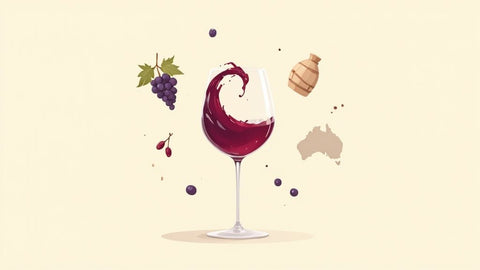
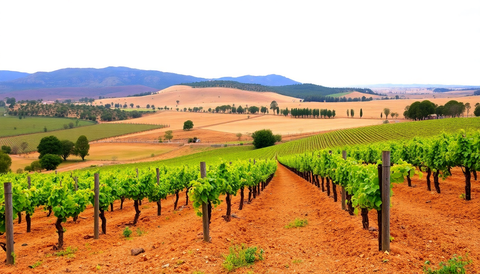

Comments (0)
There are no comments for this article. Be the first one to leave a message!